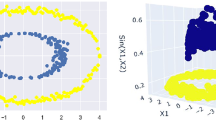Abstract
This paper concerns the design of a Support Vector Machine (SVM) appropriate for the learning of Boolean functions. This is motivated by the need of a more sophisticated algorithm for classification in discrete attribute spaces. Classification in discrete attribute spaces is reduced to the problem of learning Boolean functions from examples of its input/output behavior. Since any Boolean function can be written in Disjunctive Normal Form (DNF), it can be represented as a weighted linear sum of all possible conjunctions of Boolean literals. This paper presents a particular kernel function called the DNF kernel which enables SVMs to efficiently learn such linear functions in the high-dimensional space whose coordinates correspond to all possible conjunctions. For a limited form of DNF consisting of positive Boolean literals, the monotone DNF kernel is also presented. SVMs employing these kernel functions can perform the learning in a high-dimensional feature space whose features are derived from given basic attributes. In addition, it is expected that SVMs’ well-founded capacity control alleviates overfitting. In fact, an empirical study on learning of randomly generated Boolean functions shows that the resulting algorithm outperforms C4.5. Furthermore, in comparison with SVMs employing the Gaussian kernel, it is shown that DNF kernel produces accuracy comparable to best adjusted Gaussian kernels.
Preview
Unable to display preview. Download preview PDF.
Similar content being viewed by others
References
D. Angluin. Queries and concept learning. Machine Learning, 2:319–342, 1988.
M. Bellare and P. Rogaway. The complexity of approximating a nonlinear program. In Complexity of Numerical Optimization, pages 16–32. World Scientific, 1993.
V. Cherkassky and F. Mulier. Learning from Data. Wiley, 1998.
N. Cristianini and J. Shawe-Taylor. An Introduction to Support Vector Machines. Cambridge Press, 2000.
P. Domingos. On the optimality of the simple Bayesian classifier under zero-one loss. Machine Learning, 29:103-130, 1997.
P. Domingos. The role of Occam’s razor in knowledge discovery. Data Mining and Knowledge Discovery, 3:409–425, 1999.
M. Kearns, Ming Li, L. Pitt, and L.G. Valiant. On the learnability of Boolean formulae. ACM, pages 285–295, 1987.
R. Khardon, D. Roth, and R. Servedio. Efficiency versus convergence of Boolean kernels for on-line learning algorithms. Manuscript, 2001.
H. Liu and H. Motoda. Feature transformation and subset selection. IEEE Intelligent Systems, 13(2):26–28, 1998.
L. Pitt and L.G. Valiant. Computational limitations on learning from examples. Journal of the Association for Computing Machinery, 35(4):965–984, 1988.
J.C. Platt. Fast training of support vector machines using sequential minimal optimization. In Advances in Kernel Methods-Support Vector Learning, pages 185–208. MIT Press, 1998.
J.R. Quinlan. An empirical comparison of genetic and decision-tree classifiers. In Proceedings of International Conference on Machine Learning, pages 135–141, 1988.
J.R. Quinlan. C4.5: Programs for Machine Learning. Morgan Kaufmann, 1993.
L.G. Valiant. A theory of the learnable. Communications of the ACM, 27(11):1134–1142, 1984.
V. Vapnik. The Nature of Statistical Learning Theory. Springer-Verlag, 1995.
V. Vapnik. Statistical Learning Theory. Wiley, 1998.
Author information
Authors and Affiliations
Editor information
Editors and Affiliations
Rights and permissions
Copyright information
© 2001 Springer-Verlag Berlin Heidelberg
About this paper
Cite this paper
Sadohara, K. (2001). Learning of Boolean Functions Using Support Vector Machines. In: Abe, N., Khardon, R., Zeugmann, T. (eds) Algorithmic Learning Theory. ALT 2001. Lecture Notes in Computer Science(), vol 2225. Springer, Berlin, Heidelberg. https://doi.org/10.1007/3-540-45583-3_10
Download citation
DOI: https://doi.org/10.1007/3-540-45583-3_10
Published:
Publisher Name: Springer, Berlin, Heidelberg
Print ISBN: 978-3-540-42875-6
Online ISBN: 978-3-540-45583-7
eBook Packages: Springer Book Archive




